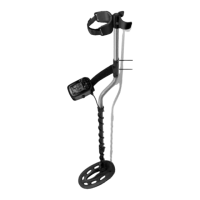9
THE BASICS OF METAL DETECTING
A hobby metal detector is intended for locating buried metal objects. When
searching for metals, underground or on the surface, you have the following
challenges and objectives:
1. Ignoring signals caused by ground minerals.
2. Ignoring signals caused by metal objects that you do not want to find, like
pull-tabs.
3. Identifying a buried metal object before you dig it up.
4. Estimating the size and depth of objects, to facilitate digging them up.
5. Eliminating the effects of electromagnetic interference from other
electronic devices.
Your metal detector is designed with these things in mind.
1. Ground Minerals
All soils contain minerals. Signals from ground minerals can interfere with the
signals from metal objects you want to find. All soils differ, and can differ greatly,
in the type and amount of ground minerals present. You therefore want to
“calibrate” the detector to the specific ground conditions where you are hunting.
The detector incorporates both automated and manual ground-balancing
features which will eliminate false signals from most types of soils. If you want
to maximize the detector’s target identification accuracy and depth of detection,
use the GROUND GRAB™ Computerized Ground Balancing function to
calibrate the detector to the ground where you are searching. See the section
on GROUND GRAB™ Computerized Ground Balancing for details.
2. Trash
If searching for coins, which will induce higher tone sounds, you want to
ignore items like aluminum foil, nails, and pull-tabs. These undesirable items
induce lower tones. You can listen to the sounds of all objects detected, and
decide on what you want to dig up. Or you can eliminate unwanted metals
from detection by using the DISCRIMINATION feature.
3. Identifying Buried Objects
When searching in the DISCRIMINATION Mode, different objects induce
different tones (high, medium, low, bass) and are classified on the display screen
in different categories from left to right. A 2-digit numerical reading is also
provided in the middle of the display for more precise target identification. The
DISCRIMINATION Mode requires motion: sweep the coil over the metal object.
4. Size and Depth of Buried Objects
When using the detector in the motion DISCRIMINATION Mode, the relative
depth of an object is displayed in the center of the display with the SIGNAL
strength indicator. A more accurate depth reading is available in a no-motion
mode, using PINPOINT. These modes display target depth in inches. This
no-motion mode does not require the coil to be in motion to detect metals.
The ability to hold the searchcoil motionless over the target also aids in
tracing an outline of the buried object, or in pinpointing the exact location of
16
GROUND BALANCING -Technical Info
Fe
3
O
4
BAR GRAPH
The Fe
3
O
4
4-segment bar graph indicates the amount of ground mineralization,
independent of type, expressed as an equivalent volume concentration of
magnetite (Fe
3
O
4
). It updates every second. It is sensitive to motion and will give
the most accurate readings if you “pump” the searchcoil up and down several times
over the ground. The presence of metal or “hot rocks” will cause the readings to be
inaccurate. If you stop moving the searchcoil, the bar graph will go blank.
INDICATION % Fe
3
O
4
SUSCEPTIBILITY
4 Bars -High 0.4 - 1.6 1,000 - 4,000
3 Bars -Medium 0.1 - 0.4 250 - 1,000
2 Bars -Low 0.025 - 0.1 60 - 250
1 Bars -Very Low 0.006 - .025 15 - 60
None - - less than .006 less than 15
Magnetic susceptibility is expressed in micro-cgs units. In a salt water environment
in the absence of iron minerals, the bar graph indicates relative electrical conductivity.
In soils with greater than 4,000 micro-cgs units magnetic susceptibility, the
signal from the soil may saturate (“overload”) the circuits. This will not harm the
detector but the machine will not be usable in that condition. The solution is to
hold the searchcoil several inches above the soil surface so it isn’t “seeing as
much dirt”. By listening and watching you will know how high you need to hold
the searchcoil in order to avoid overload.
The highest magnetic susceptibilities are usually found in soils developed over
igneous rocks, in alluvial ‘black sand” streaks on beaches, and in red clay soils
of humid climates.
The lowest magnetic susceptibilities are usually found in white beach sands of
tropical and subtropical regions, and soils developed over limestone.
Ground Error
The bottom left-hand corner of the display contains a graphic which indicates
if your detector’s ground balance setting needs to be adjusted.
The Omega has a tracking system which continuously analyzes the
phase of the
ground you are searching.
It then compares this
ground phase value with the detector’s internal Ground
Setting indicated on the bottom right of the display.
* If the detector’s internal Ground Setting is equal to the actual phase of
the ground, the detector is properly ground balanced and the Ground
Error window is clear.

